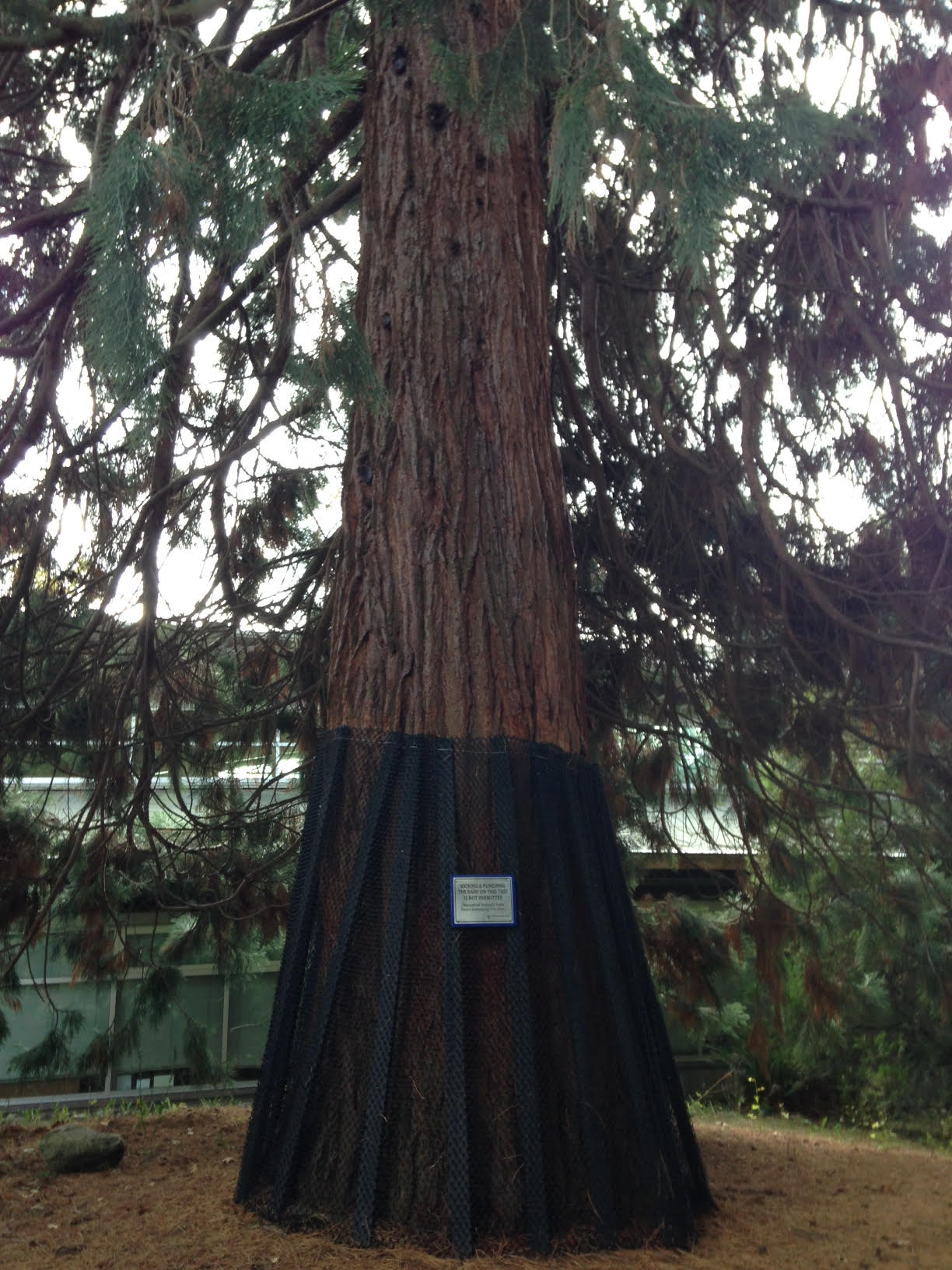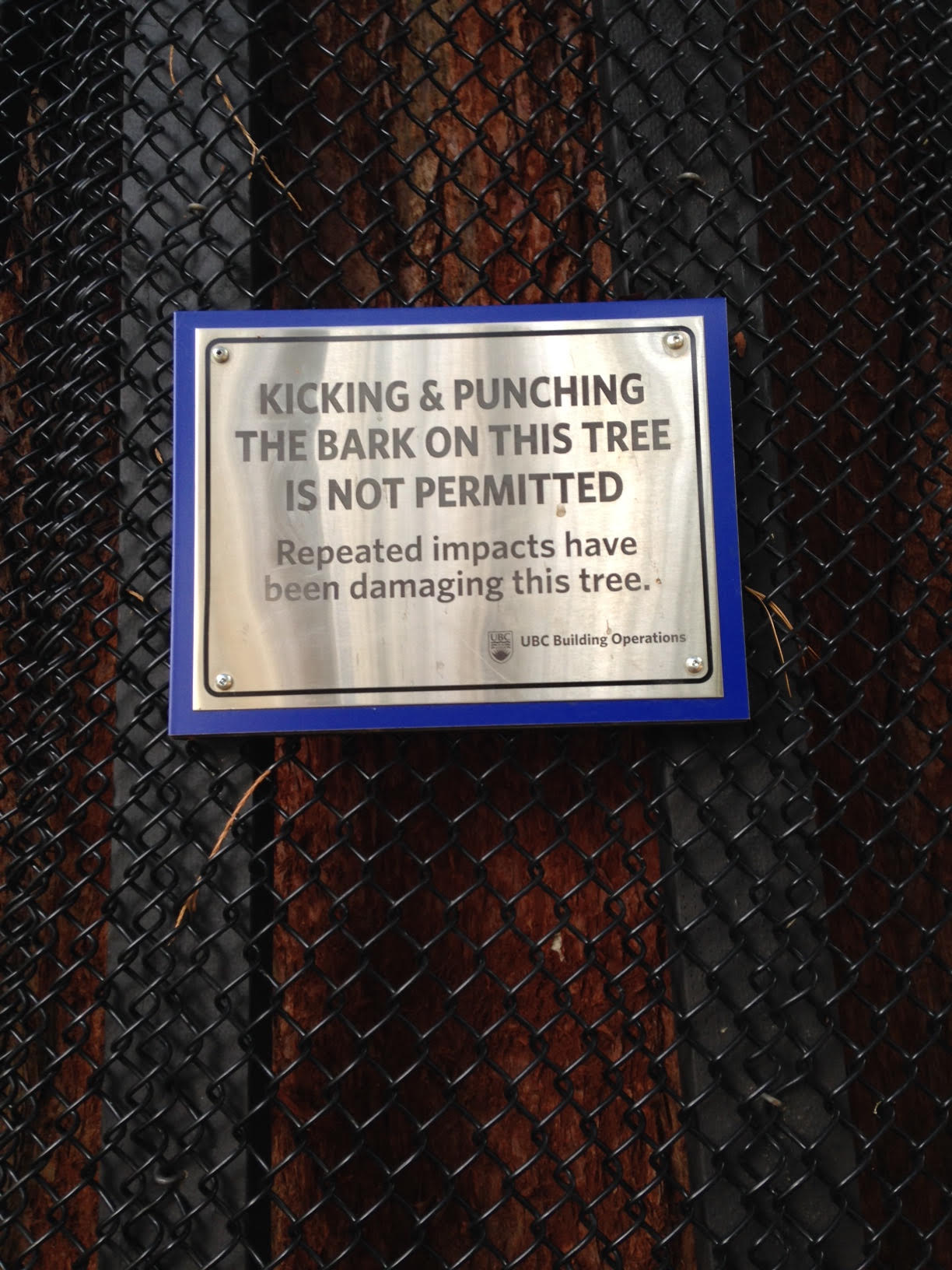this redwood tree is wearing a protective covering because it was literally beaten to a pulp. on our campus. by ubc students.
the tree, which stands on the north side of the first nations longhouse, is long known to some students as “the punching tree”. one blogger even advised the world wide web that, “you can punch it as hard as you like and you won’t hurt yourself!”
but what about the tree? after several years of beatings, the tree sustained so much damage that ubc building operations was finally forced to take action. this spring, they erected a plastic chain link fence around the tree to stop students from punching it. however, in the fall they wrapped the tree in this protective covering, because the fence wasn’t doing its job. students continued to punch the tree, stepping right over the bendy plastic fence to do so.
i had the pleasure of encountering two such students. after watching them trample over the fence to lay their fists on the tree, i approached them. in my calmest tone, i asked what they were doing, and why.
looking like they had just discovered some magical secret, they wanted to know, had i tried punching the tree? because it was great!
staying calm but delivering some serious side-eye, i replied that no, i had not tried it. and i wouldn’t be trying it. did you notice the fence, i asked? how about the damage to the bark? i explained that in my way of life, the earth is to be respected and treated with kindness. in my way of life, this was an act of violence.
at that point, the students became visibly rattled. they wanted to know who i was, and why i was there, as if i was the one who was totally out of line. they promptly ended their discussion with me and walked away.
well, they weren’t the only ones who left that conversation feeling rattled. i knew for a while about the “punching tree,” but this was my first time witnessing anyone actually punching it. i was (and still am) deeply troubled by this kind of behaviour. as a nehiyaw-nahkawekwe, my elders teach me that the land is my first mother. they teach me that the land provides us with everything we need for survival, and therefore we treat it with the utmost love and respect. they teach me that the plants, the animals, the water, and the air feed me, and therefore i am of the earth.
the elders teach me that to hurt the land is to hurt myself.
these days, i walk by this tree on a regular basis and i can’t help but connect the violence enacted on this tree to the violence enacted on my fellow female students. just over a year ago, the final of six (still unsolved) highly publicized sexual assaults was reported. due to the reality of our (in)justice system, gender violence often goes unreported for reasons like victim blaming, retraumatization, and mistrust of police. so, we can guess that this occurs more frequently on our campus than police reports would suggest.
indigenous feminists have been saying for a long time that violence on the land is connected to violence on women’s bodies. women and the earth are symbolically linked, as givers of life. colonialism and patriarchy are like diseases that have sought to control both women and the earth through violence, for profit and for power. in other words, colonial violence and gender violence are intrinsically connected. indigenous women know this better than anyone else.
andrea smith (cherokee) states that gender violence is built on a male/female binary. plants defy gender binaries, and i can’t help but wonder if that makes them especially vulnerable to brutality. my cree and saulteaux ancestors did not conceptualize gender in the narrow, rigid ways that western culture tends to. to them, gender and sexuality were much more fluid. according to smith, the patriarchal settler society targeted indigenous cultures for destruction, for precisely this reason.
i also can’t ignore that this tree, now a site of violence, stands next to the first nations longhouse, the only place on our campus that is clearly marked ‘indigenous.’ just a few feet away from the tree are sacred ceremonial grounds. is it a coincidence that this is where countless students have deemed it appropriate to unleash their pent-up aggression? i think not.
colonialism and patriarchy are big, academic-y words, that represent attitudes, structures, and systems. but what do these things look like in real life? on the day that i witnessed the tree punching, these concepts looked to me like two typical ubc students, both oozing with a sense of entitlement.
as long as colonialism and patriarchy go on uninterrupted in our individual and collective thoughts, words, and actions, we will see violence on our campus. this violence will be asymmetrically perpetuated against marginalized communities, the land, and nonhuman beings, as it is everywhere else.
this is why i am happy whenever i see students taking action to disrupt these systems, and when i see faculty and administrators empower students to take these kinds of actions. i am grateful to all those folks taking a stand against the kinder morgan pipeline, not far from the sfu campus. and i am inspired by the many indigenous folks and women i know, who refuse to be victims of violence. instead, they are warriors who demonstrate resilience for future generations.
as for the “punching tree,” i think it is so generous that it continues to give us air to breathe, in spite of how it has been treated. did you know that when a redwood dies or is cut down, a new one sprouts from its roots? like the source of my ancestral strength, its roots never die. it is a survivor, too.







